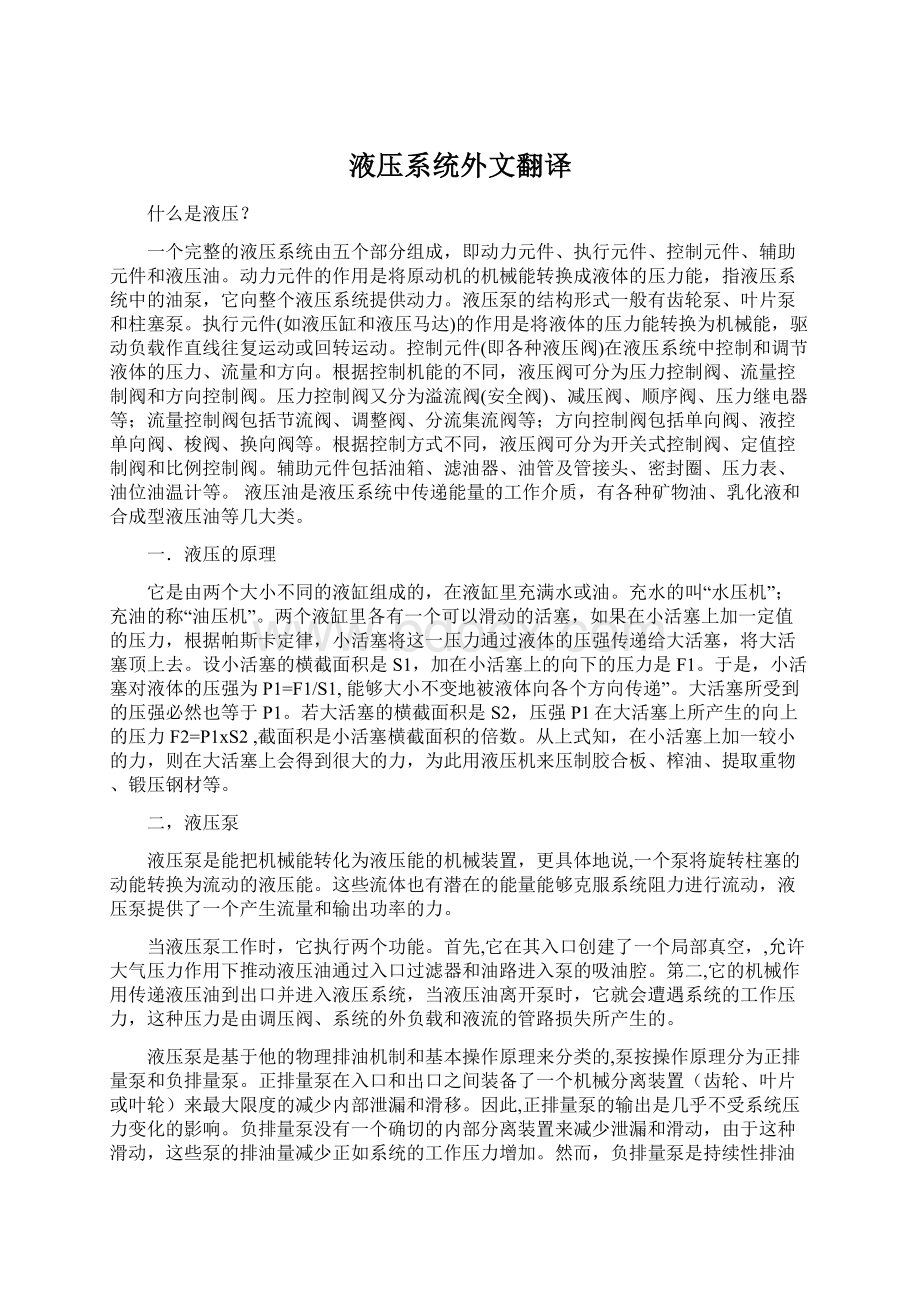液压系统外文翻译.docx
《液压系统外文翻译.docx》由会员分享,可在线阅读,更多相关《液压系统外文翻译.docx(6页珍藏版)》请在冰豆网上搜索。

液压系统外文翻译
什么是液压?
一个完整的液压系统由五个部分组成,即动力元件、执行元件、控制元件、辅助元件和液压油。
动力元件的作用是将原动机的机械能转换成液体的压力能,指液压系统中的油泵,它向整个液压系统提供动力。
液压泵的结构形式一般有齿轮泵、叶片泵和柱塞泵。
执行元件(如液压缸和液压马达)的作用是将液体的压力能转换为机械能,驱动负载作直线往复运动或回转运动。
控制元件(即各种液压阀)在液压系统中控制和调节液体的压力、流量和方向。
根据控制机能的不同,液压阀可分为压力控制阀、流量控制阀和方向控制阀。
压力控制阀又分为溢流阀(安全阀)、减压阀、顺序阀、压力继电器等;流量控制阀包括节流阀、调整阀、分流集流阀等;方向控制阀包括单向阀、液控单向阀、梭阀、换向阀等。
根据控制方式不同,液压阀可分为开关式控制阀、定值控制阀和比例控制阀。
辅助元件包括油箱、滤油器、油管及管接头、密封圈、压力表、油位油温计等。
液压油是液压系统中传递能量的工作介质,有各种矿物油、乳化液和合成型液压油等几大类。
一.液压的原理
它是由两个大小不同的液缸组成的,在液缸里充满水或油。
充水的叫“水压机”;充油的称“油压机”。
两个液缸里各有一个可以滑动的活塞,如果在小活塞上加一定值的压力,根据帕斯卡定律,小活塞将这一压力通过液体的压强传递给大活塞,将大活塞顶上去。
设小活塞的横截面积是S1,加在小活塞上的向下的压力是F1。
于是,小活塞对液体的压强为P1=F1/S1,能够大小不变地被液体向各个方向传递”。
大活塞所受到的压强必然也等于P1。
若大活塞的横截面积是S2,压强P1在大活塞上所产生的向上的压力F2=P1xS2,截面积是小活塞横截面积的倍数。
从上式知,在小活塞上加一较小的力,则在大活塞上会得到很大的力,为此用液压机来压制胶合板、榨油、提取重物、锻压钢材等。
二,液压泵
液压泵是能把机械能转化为液压能的机械装置,更具体地说,一个泵将旋转柱塞的动能转换为流动的液压能。
这些流体也有潜在的能量能够克服系统阻力进行流动,液压泵提供了一个产生流量和输出功率的力。
当液压泵工作时,它执行两个功能。
首先,它在其入口创建了一个局部真空,,允许大气压力作用下推动液压油通过入口过滤器和油路进入泵的吸油腔。
第二,它的机械作用传递液压油到出口并进入液压系统,当液压油离开泵时,它就会遭遇系统的工作压力,这种压力是由调压阀、系统的外负载和液流的管路损失所产生的。
液压泵是基于他的物理排油机制和基本操作原理来分类的,泵按操作原理分为正排量泵和负排量泵。
正排量泵在入口和出口之间装备了一个机械分离装置(齿轮、叶片或叶轮)来最大限度的减少内部泄漏和滑移。
因此,正排量泵的输出是几乎不受系统压力变化的影响。
负排量泵没有一个确切的内部分离装置来减少泄漏和滑动,由于这种滑动,这些泵的排油量减少正如系统的工作压力增加。
然而,负排量泵是持续性排油,正排量泵是间歇(脉动)的排油,这些脉动很小,可以通过蓄能器和系统管路消除。
大多数液压泵是回转型的正排量容积泵。
正排量泵分为定量泵和变量泵。
定量泵的流量只能通过改变泵的转速来调节,因为泵的抽吸装置的物理机制是无法改变的。
(这并不意味着液压系统的其他部分不可以通过阀门来调节。
)
变量泵可以通过一个内置的控制装置来改变泵的抽吸装置的物理机制,这个控制装置通常是用来相应系统压力和其他信号。
变量泵比定量泵更复杂,因此成本更高。
此外变量泵的效率也比定量泵的效率要低。
这些变量泵低效率有些时候抵消了部分更高的系统整体效率。
大多数正排量泵被分类为旋转泵。
这是因为液压油从入口到出口有一个旋转的过程。
旋转泵通过它的排油机制进一步划分为齿轮泵、叶片泵、螺杆泵。
柱塞泵是一种不同的正排量泵,这种泵是使用一种往复(来回)式运动的柱塞,交替的在吸油口吸油,出油口排油。
一个旋转装置和数个活塞组构成了一个径向柱塞泵,因此它能被分类为旋转泵。
不同泵的性能的评估是基于许多因素,包括物理特性、运行机制以及成本。
当选者一个泵时,应考虑遵循泵的功率选择因素。
排量,压力,能耗,转速效率,可靠性,流量,大小和重量,操作适应性,使用寿命安装和维护成本。
我们主要通过一个泵的容量来评价它。
这也可以被称作供油速度、流量、容积输出。
这种能力通常是在制定操作条件下每分钟多少加仑,多少立方英寸,或者一次循环输出多少立方英寸。
泵能力的评级通常在标准大气进气压力和各种输出压力,以及在相似的流体使用温度下。
一个泵压力等级一般是基于泵能够承受的压力能力并且没有一个不良的内部泄漏(或滑脱)或泵零件损坏的增加。
泵额定压力是在相同条件下(速度、温度、和入口压力)进行的能力的评估。
大多数泵额定压力在100,500,1000,1500,2000,3500或5000磅每平方英寸。
能耗是一个重要的考虑因素,不仅仅是在泵的选择上,而且还是在系统安装完成后泵的操作性能上。
这个能耗取决于泵压力,和给定时间内泵的输送流量。
泵通常的可用的电动马达一般额定在1200-1800转/分钟。
这一可以是其他的额定的速度而不是电动机速度。
例如,更高的速度发生在由内燃机驱动的变速液压泵。
这些引擎通常运行在一个恒定的速度,包括2000转/分钟甚至更高的速度。
一些工业液压泵额定速度甚至高达4000转/分钟。
旋转泵的最大安全速度是有限的,它使得泵有能力去避免气穴现象和过高的出口压力。
大多数旋转泵还需要一个最低运转速度,尽管这些速度通常都不是关键,泵在高压下需要最低速运转以避免过热和内部滑移。
泵最大额定速度和最大额定压力是在间歇和连续操作中共同确定的,连续额定运转在最大速度和最大压力下,泵在一个正常的使用寿命(大约1000小时)运转。
间歇运转是在最大速度和最大压力下,泵能够在短时间内安全运行并且有一个符合要求的使用寿命。
操作一个液压泵超出其额定速度通常会减少它的使用寿命。
早些时候就已经指出,液压系统施加在液压泵上的压力直接影响泵的供油速度。
随着压力的增加,泵流量减少,减少这种数量的变化取决于泵的使用种类。
这种变化继而影响泵的效率。
泵效率是用两种方式来叙述:
容积效率-实际流量和理论流量的比值,总效率-输出功率和输入功率的比值。
泵的可靠性取决于如何使泵的特点与系统需求,可靠性也可以从维修时间来判断。
所有的项目包括额定流量、液压系统设计的优劣和维护,泵的安装位置以及它的持久性,这些都与可靠性有关。
一个泵的使用寿命是认定操作的时间。
许多有液压泵的使用寿命是10000小时,或者大约一年。
其他的泵运转三到五年,每年大约5000小时,总计15000小时甚至更多。
使用寿命也取决于设计和泵的结构以及它的用途.
WhatisHydraulic?
Acompletehydraulicsystemconsistsoffiveparts,namely,powercomponents,theimplementationofcomponents,controlcomponents,nopartsandhydraulicoil.Theroleofdynamiccomponentsoftheoriginalmotivefluidintomechanicalenergytothepressurethatthehydraulicsystemofpumps,itistopowertheentirehydraulicsystem.Thestructureoftheformofhydraulicpumpgearsaregenerallypump,vanepumpandpistonpump.Implementationofcomponents(suchashydrauliccylindersandhydraulicmotors)whichisthepressureoftheliquidcanbeconvertedtomechanicalenergytodrivetheloadforastraightlinereciprocatingmovementorrotationalmovement.Controlcomponents(thatis,thevarioushydraulicvalves)inthehydraulicsystemtocontrolandregulatethepressureofliquid,flowrateanddirection.Accordingtothedifferentcontrolfunctions,hydraulicvalvescanbedividedintothevillageofforcecontrolvalve,flowcontrolvalvesanddirectionalcontrolvalve.Pressurecontrolvalvesaredividedintobenefitsflowvalve(safetyvalve),pressurereliefvalve,sequencevalve,pressurerelays,etc.;flowcontrolvalvesincludingthrottle,adjustingthevalves,flowdiversionvalvesets,etc.;directionalcontrolvalveincludesaone-wayvalve,one-wayfluidcontrolvalve,shuttlevalve,valveandsoon.Underthecontrolofdifferentways,canbedividedintothehydraulicvalvecontrolswitchvalve,controlvalveandsetthevalueoftheratiocontrolvalve.Auxiliarycomponents,includingfueltanks,oilfilters,tubingandpipejoints,seals,pressuregauge,oillevel,suchasoildollars.Hydraulicoilinthehydraulicsystemistheworkoftheenergytransfermedium,thereareavarietyofmineraloil,emulsionoilhydraulicmoldingHopcategories.
一.Hydraulicprinciple
Itconsistsoftwocylindersofdifferentsizesandcompositionoffluidinthefluidfullofwateroroil.Wateriscalled"hydraulicpress";thesaidoil-filled"hydraulicmachine."Eachofthetwoliquidaslidingpiston,iftheincreaseinthesmallpistononthepressureofacertainvalue,accordingtoPascal'slaw,smallpistontothepressureofthepressurethroughtheliquidpassedtothelargepiston,pistontopwillgoalongwaytogo.Basedcross-sectionalareaofthesmallpistonisS1,plusasmallpistoninthedownwardpressureontheF1.Thus,asmallpistonontheliquidpressuretoP=F1/SI,
Canbethesamesizeinalldirectionstothetransmissionofliquid."BythelargepistonisalsoequivalenttotheinevitablepressureP.Ifthelargepistonisthecross-sectionalareaS2,thepressurePonthepistonintheupwardpressuregeneratedF2=PxS2
Cross-sectionalareaisasmallmultipleofthepistoncross-sectionalarea.Fromthetypeknowntoaddinasmallpistonofasmallerforce,thepistonwillbeingreatforce,forwhichthehydraulicmachineusedtosuppressplywood,oil,extractheavyobjects,suchasforgingsteel.
二.Hydraulicpump
Ahydraulicpumpisamechanicaldevicewhichconvertsmechanicalenergyintohydraulicenergy.Morespecifically,apumpconvertsthekinetic(moving)energyofarotatingshaftintothekineticenergyoffluidflow.Thefluidflowalsohaspotentialenergythatallowsittoovercometheresistanceofthesystemtofluidflow.Rememberthatapumpprovidestheforceproduceflowandtransmitpower.Hydraulicpressureiscausedbytheloadonthesystemandbytheresistanceofthehydraulicsystemtofluidflow.
Whenoperating,ahydraulicpumpperformstwofunctions.First,itcreatesapartialvacuumatitsinlet,permittingtheatmosphericpressureinthefluidreservoirtopushthehydraulicfluidthroughtheinletstrainerandlineintothepump.Second,itsmechanicalactiondeliversthefluidtoitsoutletandintothehydraulicsystems,asshowninFig.5-1.Asthefluidleavesthepump,itencounterstheworkingpressureinthesystem.Thispressureisproducedbythepressureregulatingvalve,thesystemworkload,andflowlossesinthehydraulictubing
Apumpisclassifiedonthebasisofthephysicalarrangementofitspumpingmechanismanditsbasicprincipleofoperating.Pumpsclassifiedbyprincipleofoperationincludepositivedisplacementandnonpositive-displacementtypes.
Positive-displacementpumps,areequippedwithamechanicalseparation(gears,vanes,orimpellers)betweentheinletandoutlet,whichminimizesinternalleakageorslippage.Therefore,theoutputofpositive-displacementpumpsisalmostunaffectedbyvariationsinsystempressure
Nopositive-displacementpumps(suchascentrifugalpumps)donothaveapositiveinternalseparationagainstleakageorslippage.Becauseofthisslippage,thedeliveryofthesepumpisreducedastheworkingpressureofasystemisincreased.However,nonpositive-displacementpumpsdeliveracontinuousflow,whilepositive-displacementpumpsdeliveranintermittent(pulsating)flow.Thesepulsationsaresmallandcanbesmoothoutbytheaccumulatororthesystempiping.Mosthydraulicpumpsarepositive-displacementpumpsoftherotarytype.
Positive-displacementpumpshaveeitherafixedorvariabledisplacement.Thevolumeofdelivery,orgpm,ofafixed-displacementpumpcanbechangedonlybychangingthespeedofthepump,becausethephysicalarrangementofthepumpingmechanismcannotbechanged,(Thisdoesnotmeanthattheflowinotherportionsofthesystemcannotbeadjustedbyvalves.)
Theflowofavariable-displacementpumpcanbechangedbychangingthephysicalarrangementofthepumpingmechanismwithabuilt-incontrollingdevice.Thisdeviceoftenfunctionsinresponsetosystempressureorothersignals.Variable-displacementpumpsaremorecomplexthanfixed-displacementpumpsand,therefore,costmore.Inaddition,theefficiencyofavariable-displacementpumpislowerthanthatofafixed-displacementpump.Thisisoffsetsomewhatbythehigheroverallefficiencyofasystempoweredbyavariable-displacementpump.
Mostpositive-displacementpumpsareclassifiedasrotarypumps.Thisisbecausetheassemblythattransfersthefluidfromthepumpinlettothepumpoutlethasarotatingmotion.Rotarypumpsarefurtherclassifiedaccordingtothemechanismthattransfersthefluid-suchasgears,vanes,orscrews.
Adifferentkindofpositive-displacementpumpispistonpump.Thispumpusesareciprocating(back-and-forth)motionofthepiston,alternatelytoreceivefluidontheinletside,andtodischargefluidontheoutletside.Aradial-pistonpumphasarevolvingassemblywithseveralpistonassembliesbuiltintoit,andcanbeclassifiedasarotarypump.Severaltypesofpistonpumpswillbediscussedlaterinthischapter.
Theperformanceofdifferentpumpsisevaluatedonthebasisofmanyfactors,inculdingphysicalcharacteristics,operatingcharacteristics,andcost.Whenselectingapump,thefollowpumpratingandselectionfactorsareconsidered;
Capacity,Pressure,Energyconsumption,Drivespeed,Efficiency,Reliability,Fluidcharacteristics,Sizeandweight,Controladaptability,Servicelife,Installationandmain